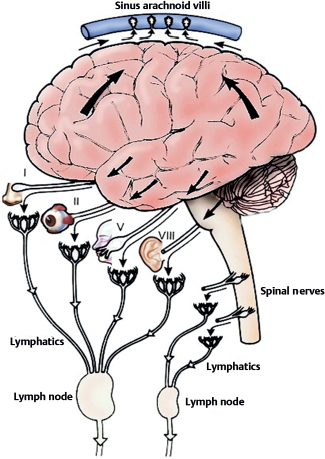75 Where is CSF produced? In the choroid plexus of the lateral ventricles and roof of the third and fourth ventricles Anywhere else? Yes. There is an unclear number of extrachoroidal sources of CSF production. What are those sources? Parenchymal subarachnoid space and ependymal surface What is the production rate of CSF? 0.33 cc/min, not influenced significantly by the intracranial pressure (ICP) What is the primary site of absorption? Via arachnoid villi into the dural sinuses at the convexities True or false: Arachnoid villi only exist near the sagittal sinus. False; there are spinal arachnoid villi as well, near the spinal root ganglia. Does this process require energy? No. This is a process that does not require energy (valvular system). It is based both on a hydrostatic pressure difference between the subarachnoid space and venous sinuses as well as on an “osmotic gradient” created due to the fact that protein content in plasma is significantly greater than in CSF. Is absorption at the sagittal sinus influenced by outflow pressure? Yes, indeed. It is influenced as well by the gradient between ICP and that of the sagittal sinus (5–7 mm Hg). Any other proposed mechanisms of absorption of CSF? Via choroid plexus and “lymphatic type” drainage. It is important to recognize that this drainage contribution, although not as important in magnitude, constitutes an exciting area of research. What does the “lymphatic type” drainage consist of? Absorption from subarachnoid space → craniospinal perineural spaces → lymphatics The main point of CSF drainage from the cranial spaces to the lymph runs through what structure? The cribriform plate, via the subarachnoid space around the olfactory nerves into the submucosal space, located underneath the nasal epithelium Fig. 75.1 Schematic absorption mechanisms of CSF. (Modified from Kida, S., R. O. Weller, et al. [1995]. “Anatomical pathways for lymphatic drainage of the brain and their pathological significance.” Neuropathol Appl Neurobiol 21;3:181–4. New York: John Wiley & Sons. Reprinted by permission.)
General Concepts

General Concepts
Only gold members can continue reading. Log In or Register to continue

Full access? Get Clinical Tree






